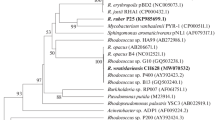Abstract
Previous studies demonstrated that Alcaligenes eutrophus A5 transforms 1,1,1-trichloro-2,2-bis(4-chlorophenyl)ethane (DDT) to 4-chlorobenzoate via a meta-ring fission product. The initial reactions could be catalyzed by either monooxygenase or dioxygenase enzymes. In the present study, a transient intermediate that accumulated during the transformation of DDT by the biphenyl-grown cells was identified as 1,1,1-trichloro-2-(4-chlorophenyl-2,3-dihydro-4,6-cyclohexadiene)-2-(4′-chlorophenyl)ethane (DDT-2,3-dihydrodiol) on the basis of mass spectral analysis after n-butylboronic acid derivatization. The dihydrodiol undergoes a characteristic acid-catalyzed dehydration to produce phenols. 1H-NMR indicated a cis-relative stereochemistry. The results indicate that the biphenyl dioxygenase from A. eutrophus A5 catalyzes the dihydroxylation of DDT at the unsubstituted carbons on the aromatic ring to produce DDT-2,3-dihydrodiol.
Similar content being viewed by others
Author information
Authors and Affiliations
Additional information
Received: 22 July 1998 / Accepted: 6 October 1998
Rights and permissions
About this article
Cite this article
Nadeau, L., Sayler, G. & Spain, J. Oxidation of 1,1,1-trichloro-2,2-bis(4-chlorophenyl)ethane (DDT) by Alcaligenes eutrophus A5. Arch Microbiol 171, 44–49 (1998). https://doi.org/10.1007/s002030050676
Issue Date:
DOI: https://doi.org/10.1007/s002030050676




